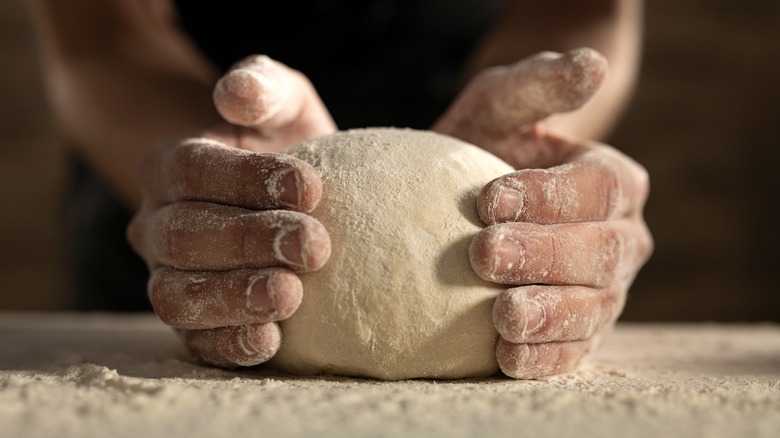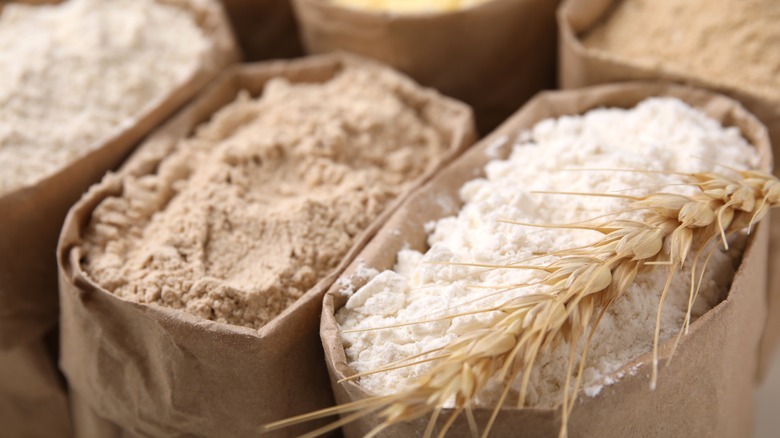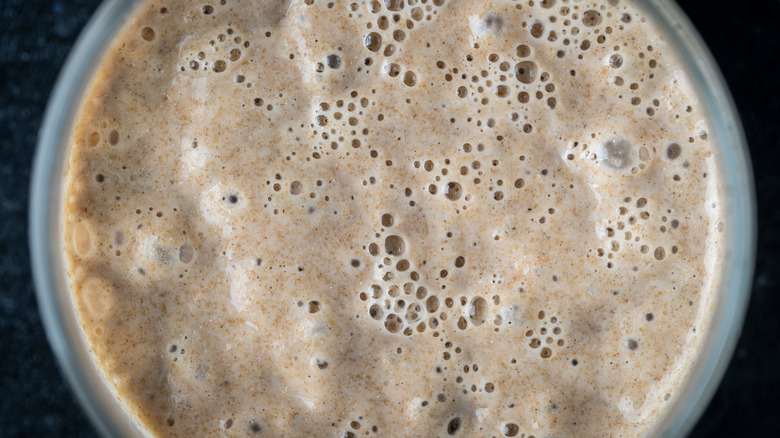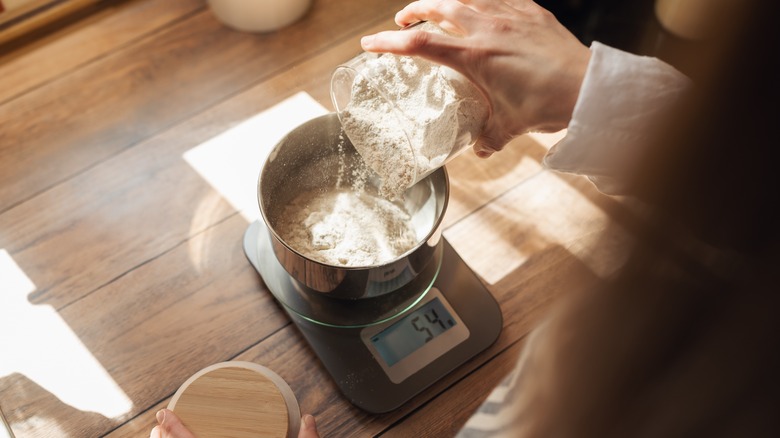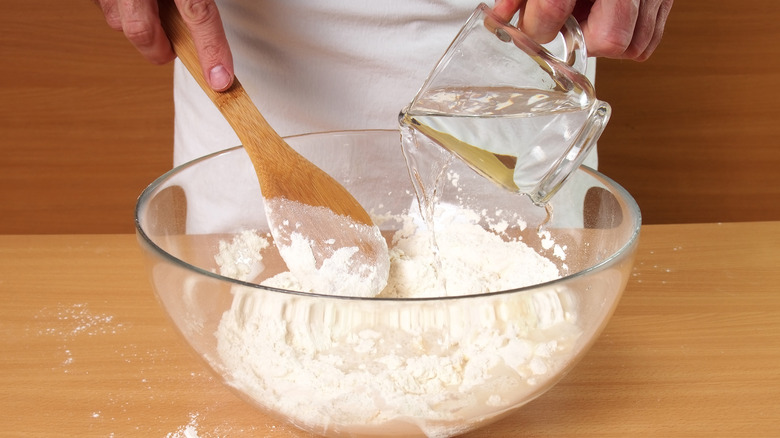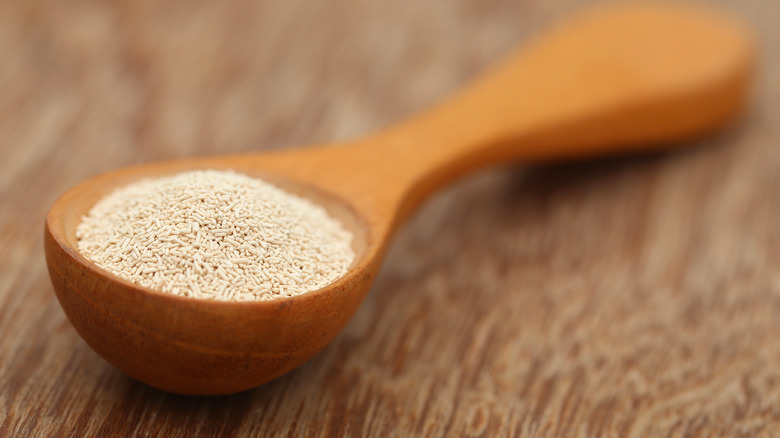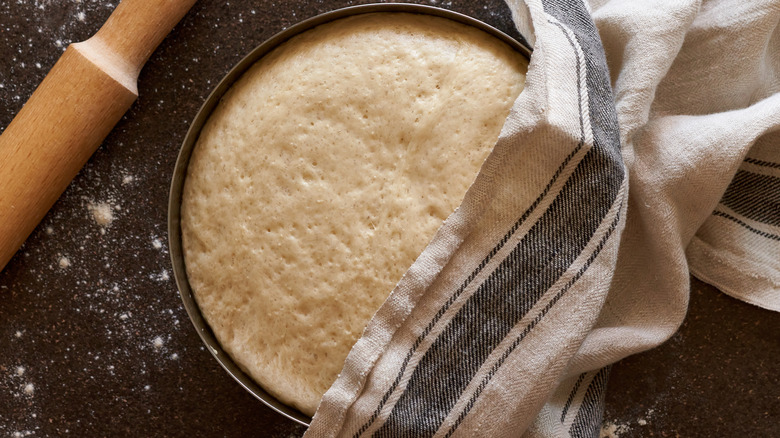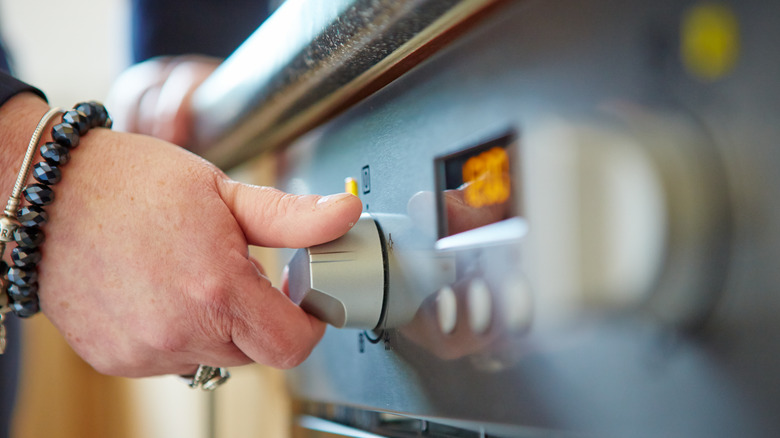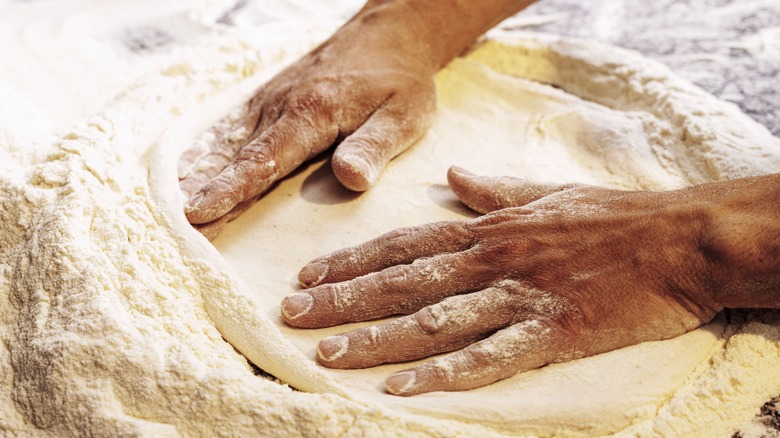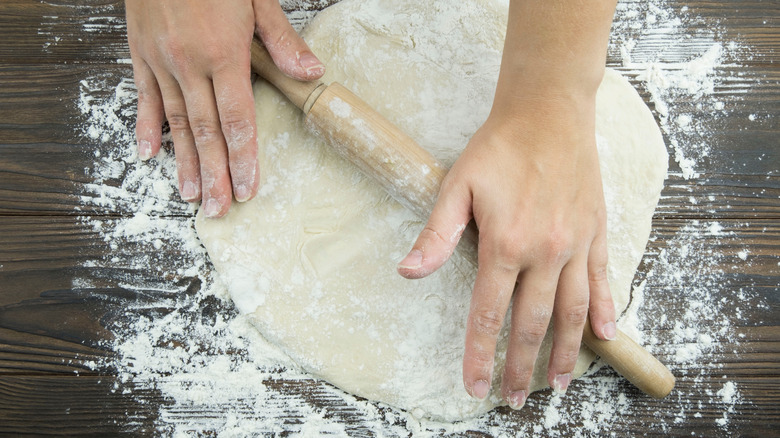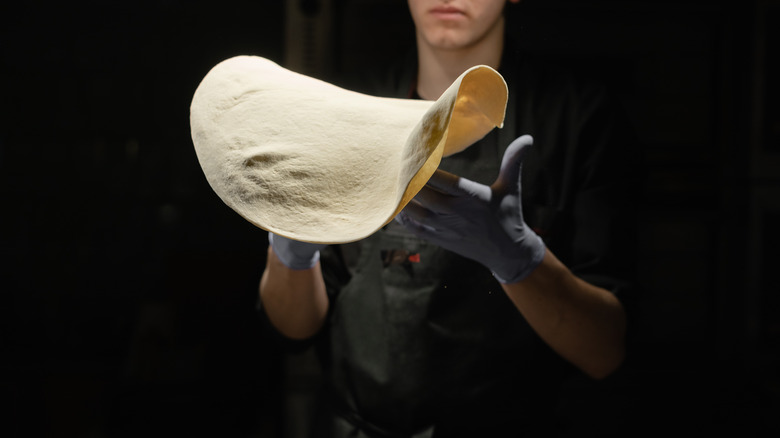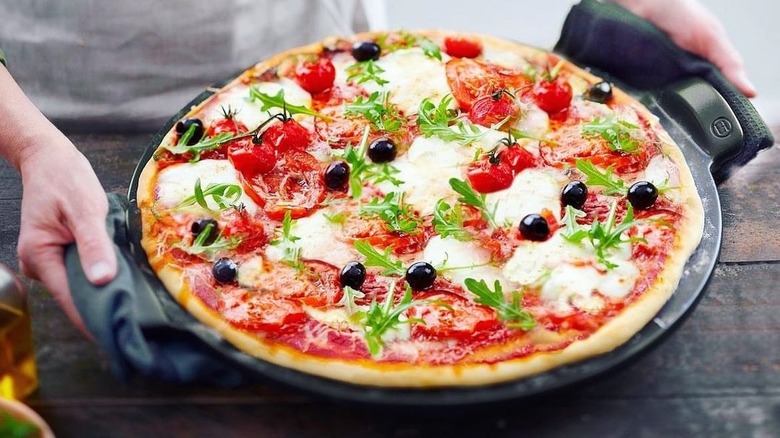Mistakes Everyone Makes With Their Homemade Pizza Dough
Any budding home cook who has visited Italy or simply had a perfect pizza in a local pizzeria has contemplated trying to recreate it at home — but many are put off at the thought of making their own pizza dough. While it's a process that requires both patience and skill, it is not as tricky as you may believe.
Pizzas are synonymous with Naples, and a true Neapolitan pizza is crisp, light, and airy, far removed from the deep-dish versions that have become an American staple. From using a rolling pin to stretch your pizza base to choosing the wrong flour, there are several crucial mistakes many of us make that will prevent your pizza dough from hitting the spot. However, with a little guidance, a beautiful Italian pizza is achievable in your own kitchen.
Join us as we uncover the common mistakes everyone makes with homemade pizza dough — and, of course, how to overcome them. With the right tools and enough patience, you can create a slice of Italy that will wow your family and any diehard pizza-loving guests.
Using the wrong type of flour
Make sure you have the best ingredients before you set out to make your homemade pizza dough — and you'll begin with the star of the show: the flour. To make a true Italian pizza base, only one flour will do. Tipo 00 flour, also known as doppio zero, is the best flour to use when making authentic pizza or pasta.
In Europe, when flour is ground, the size is numbered from double zero to two, with two being the biggest grind and double zero the finest. For the silkiest, stretchiest dough possible, you want the finely ground stuff that the Neapolitans use for the most famous pizzas on the planet. While all-purpose flour will still work, you can't expect to get a perfect pizza base without doppio zero.
Though the grading of 00 does not refer to protein content, most double zero flours consist of around 12-13% protein, creating the pizza dough texture we are familiar with. If you are unable to find doppio zero flour in your local grocery store, there are many specialist Italian websites that will deliver to your door, ensuring that you are equipped with the best possible culinary flour to make a perfect pizza base.
Using too much yeast
As you probably know, yeast is a crucial ingredient in your pizza dough, without which your pizza would fall a bit flat. You may have heard that adding more yeast will allow your dough to rise more quickly, but it is not as simple as that, and adding too much yeast can prove just as problematic as too little.
Yeast is essential in making dough rise, due to the process of fermentation. Yeast feasts on the sugars in the flour, creating bubbles of carbon dioxide and alcohol as it does so. This not only causes the dough to increase in size and become light and airy in texture but also gives the crust the familiar tangy pizza flavor. Using an excess of yeast will speed this process up, giving the dough less time to develop its unique flavors. It could also cause the dough to over-ferment, meaning the flavor goes from deliciously tangy to unpalatably sour, with an overpowering taste of alcohol. A moderate amount of yeast is key to ensure the dough rises well but doesn't end up over-fermented.
Guessing the quantities of ingredients
As a home cook, if you are used to cooking mostly savory dishes, you may think you can roughly measure the ingredients for your dough with little impact on the final outcome. When whipping up a curry, a pinch of salt and a dash of cream will suffice, saving you the effort of washing your measuring spoons. However, making dough lies firmly in the baking category of the culinary world, and even the slightest change in the ratio of ingredients can affect the success of your pizza.
When making your pizza dough for the first time, find a reliable recipe and stick to it. Measure out your ingredients with a set of kitchen scales, ideally digital ones that allow you to switch from measuring weight to volume so that you can portion out solids and liquids using the same set of scales.
Unlike day-to-day cooking, baking is a science that requires precision measurements and strict following of the recipe. Too much or too little flour in your dough could ruin your pizza completely, meaning you have to start afresh with a new batch. To save yourself time and frustration further down the line, take a few minutes at the start to measure out all of your ingredients properly and follow your recipe to the letter.
Getting the amount and temperature of water wrong
When it comes to adding water to your dough, there are two factors you need to consider — the amount of water you use and its temperature. Water is added to yeast to activate it, but the temperature you use is crucial. If cold water is used, the production of bubbles of carbon dioxide will be too slow, leaving your dough flat. However, yeast is a living organism, meaning that temperatures above 100 degrees Fahrenheit will kill it, so it is important not to use water that is too hot. Warm water between 100 and 110 degrees Fahrenheit will give the perfect balance to get the most out of your yeast.
As well as temperature, there is the question of how much. Water is needed to make the dough supple and stretch, but too much will result in a sticky mess that is impossible to work with. If you find you have overhydrated your dough, add some flour in — a little at a time — until you end up with a mixture that is elastic enough to roll but won't stick to everything in the process.
Using old yeast
When making up your weekly grocery list, yeast is an ingredient that is unlikely to feature very often. Most of us have a box of yeast at the back of a kitchen cupboard that we frantically hunt for every so often when bread or pizza making is on the agenda. However, it is important to check the expiration date on your yeast and replace it regularly, as old yeast may not work as effectively.
If your yeast has been stored properly according to the instructions on the package, it will likely be usable for about four months after the expiration date. Once opened, a packet of yeast can be kept in the fridge for a few months. If you have yeast that you think may be past its best, there is a simple test. Mix the yeast with sugar and warm (not hot) water and leave for 10 minutes. You are good to go if bubbles appear and you can detect that distinctive yeasty smell. If not, you will need to replace your yeast on the next trip to the grocery store. By keeping an eye on the freshness of the yeast, you can keep your pizza base light and airy with a beautiful tangy crust.
Not letting the dough rest
In your excitement at making your own dough, you may be keen to stretch out the dough and get to the fun of adding toppings. But, having gone to the effort of making the perfect dough, it is important to let it rest properly before continuing to the next step.
Resting or proofing the dough gives the yeast a chance to do its work and allows the dough to double in size. This takes at least 30 minutes, though 90 minutes is better if you can afford the time. To prevent it from drying out, let your dough rest in a bowl covered with a damp dishcloth. If you are making your dough for the following day, prove it in the fridge overnight for up to 24 hours. Resting also allows the gluten from the flour to relax, resulting in a light, airy pizza crust.
Patience is key when it comes to your pizza dough. Leave plenty of time for resting your dough before stretching and adding toppings — or make it the day before and let it proof in the fridge instead.
Not preheating the oven
If you want to replicate a true Italian pizza from your home oven, the importance of preheating your oven cannot be emphasized enough. According to pizza oven manufacturers Forno Piombo, authentic pizzas are cooked in ovens that reach as high as 1,000 degrees Fahrenheit, so making sure your pizza hits a piping hot oven is essential. Because of the wet toppings on your pizza, a high temperature is needed to prevent the base from collapsing into a soggy mess. If you don't preheat your oven and allow the pizza to heat up slowly, the outside of the crust will begin to crisp up without the base cooking, meaning your pizza is heading toward textural disaster.
To recreate the searingly hot pizza ovens, it's crucial to cook your pizza at the right temperature, too. The ideal temperature is around 500 degrees Fahrenheit, which for most home ovens means turning the heat up to the max. This allows the pizza to cook quickly, resulting in a crust that is crispy but not burnt.
Overhandling the dough
One of the fun steps in making your own pizza is kneading the dough. Getting stuck in and getting your hands messy is oddly satisfying, and you may be tempted to keep kneading the dough for as long as possible. However, while kneading is a crucial aspect of creating a great pizza, over-kneading the dough can be problematic.
Kneading the dough encourages gluten strands to be formed, making the dough stronger as the network of gluten is expanded. Around 10 minutes of kneading by hand should be sufficient for this to happen. If you continue to knead far beyond this point, though, the gluten network will become too strong, and the dough will not be able to relax. This can also happen if you knead your dough with a food processor, as the process will happen too quickly.
So, treat your handmade dough with care, kneading it firmly but gently for up to 10 minutes, then resisting the temptation to continue. Trust that your perfectly made dough will result in a light, crispy base that will create a pizza with wonderful texture and flavor.
Using a rolling pin
It may be second nature to reach for a rolling pin to roll out your pizza dough, but it's not the best option if you want a light, airy crust. All the lovely bubbles that appeared in the dough while it was resting will be destroyed under the weight of a rolling pin, making your pizza base flatter than it should be.
Though rolling your pizza base is easier, mastering the art of hand-stretching your dough will pay dividends in the long run. If you have followed the other tips in this article, your dough should have a good level of elasticity, meaning it should stretch without tearing.
Though you may have watched in awe at a pizzeria as an experienced chef tossed their dough high into the air to stretch it, there is no need for advanced pizza acrobatics in the kitchen. Flipping a circle of dough gently between your hands will cause it to stretch, and if you have patience, you will eventually end up with a circle large enough to call a pizza.
With practice, your hand-stretched dough will increase in diameter and have a uniform thickness resembling a true Neapolitan pizza. So, if you can, ditch the rolling pin and challenge yourself to give authentic hand stretching a go — you'll be glad you did!
Not stretching it thinly enough
To create the perfect Italian-style pizza, you will have to master the art of stretching the dough thin enough that it is crisp and light but not so thin that it tears. Thick, doughy crusts are not a feature of traditional Neapolitan pizzas, so a thin, crunchy base is what you should be aiming for. It should have enough strength to hold whatever assortment of toppings you choose but be light enough to provide a satisfying crunch when you bite into it.
As you stretch your dough, keep an eye on how even it is, as thick, doughy sections will ruin the texture of your otherwise thin and crispy pizza. Similarly, be careful of any parts that may be so thin they are likely to tear, as once the topping is applied, a tear could end in a tomatoey disaster.
Patience is key when stretching your dough, and it is unlikely you will get a perfectly thin base on your first attempt. As you refine your pizza-making technique, your base will become increasingly uniform and robust, allowing you to let your artistic flair show as you add all of your favorite toppings.
Not using a pizza stone
To help your pizza on its way once it hits the oven, consider investing in a pizza stone. Without this handy device, getting a perfectly crisp base will be very difficult unless you have a traditional wood-fired oven in your kitchen. Most pizza ovens have a brick base that gets extremely hot and retains heat well, meaning as soon as the pizza is added, it begins to cook rapidly.
To recreate this effect in your kitchen, preheat a pizza stone in the oven before adding your homemade pizza to it and returning it to the oven. They are generally made from stone or ceramic, both of which retain heat well.
By placing your pizza on the preheated stone, the base will begin to cook straight away, meaning the pizza will be ready more quickly, and the bottom will not be soggy. It goes without saying that the pizza stone will be extremely hot, and heavy-duty oven gloves will be required to move it to and from the oven.

